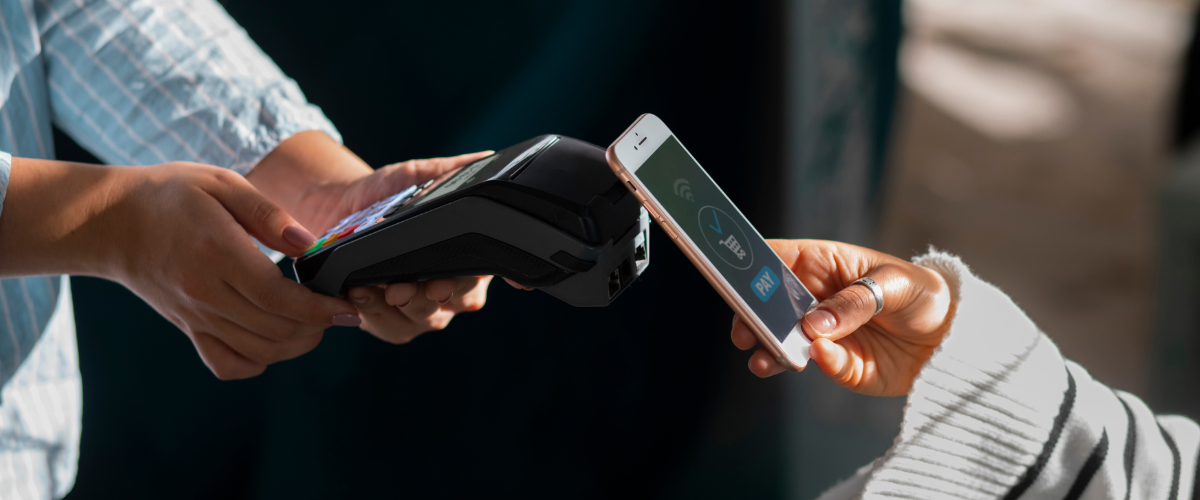
Mobile banking in Africa during COVID
Mobile banking in Africa: Changes & Challenges

COVID has had an enormous impact on almost every aspect of life, and financial services have been especially hit throughout this crisis. Consumer behavior was forced to change due to the risk of infection, which has shifted the old dynamics in terms of communication and access.
Before the pandemic, African markets were experiencing steady economic growth. In North Africa, economic growth was expected to reach between 4.4 and 4.5 percent in 2020 and 2021, respectively, while Sub-Saharan Africa was projected to rise to 3.6 percent in 2020, according to the International Monetary Fund (IMF). However, since COVID-19 struck, the outlook has been less than favourable, with an economic contraction estimate of 1.9 percent in Sub- Saharan Africa (SSA) in 2020.
COVID-19’s impact on financial inclusion
Financial inclusion barriers were slowly yet steadily improving in Africa thanks to the democratization of financial services. However, lockdowns, curfews, and the health risk posed by closed spaces with too many people resulted in many stores closing branches and avoiding large crowds of consumers.
Mobile device penetration in Africa has been increasing exponentially in the last few years, and according to GSMA estimations, in 2020, 80 percent of the 800 million people living in Sub-Saharan Africa already have a mobile device, partly due to the strides mobile banking has had in the region. Smartphones have also experienced massive growth: according to Informa, Africa has gone from 79 million devices in 2012 to 412 million in 2018.
This scenario, combined with the risks COVID poses, provides the perfect opportunity for users to turn to their devices to handle their day-to-day tasks, including grocery shopping, entertainment, etc. In fact, according to McKinsey’s May 2020 Consumer Sentiment in South Africa during the COVID crisis, there is up to a 90 percent growth in online intent.
These actions are mainly driven by convenience since it’s more easily accessible from home, as well as less crowded or with shorter waiting times.
Recent studies show that digital financial inclusion can even have a more significant impact on economic growth, while also helping reduce poverty and close the income gap without negatively affecting financial stability, as long as it is supported by the right regulatory framework.
What has the COVID-19 pandemic meant for the financial industry?
Even before the pandemic, African consumers were already starting to rely more on their devices, but without a doubt, COVID has caused an acceleration in these behaviors. Some African governments even released stimulus grants via mobile money platforms and central banks have eased regulations on mobile transaction limits, which has led to the outstanding growth of mobile banking platforms.
According to McKinsey’s Africa Consumer Sentiment Survey in 2020, customers indicated an increase of online banking usages of 30 to 40 percent, mainly due to physical distances.
Although banks are still questioning whether these changes will continue once the pandemic is over,McKinsey’s survey reveals that once the pandemic is over,30 to 40 percent of consumers expect to increase their use of digital channels, while 30 percent will reduce their visit to bank branches.
Banking revenues, according to McKinsey, will fall between 23 and 33 percent between 2019 and 2021, while banks’ return on equity (ROE) could experience a fall of 5 to 15 percent, mainly due to an increase in risk costs and lower margins. Banks will only be able to go back to pre-crisis levels in 2022 if they can recover rapidly, and in 2024, if their recovery is slower.
In light of these data, many financial institutions have taken action in the midst of the pandemic, choosing to create partnerships with fintech firms, building their own agent networks to expand their banking services, with special offerings to compete against their rivals, as well as partnering with telcos to access broader customer bases and increase their reach.
Where can we go from here?
These are still uncharted waters for financial institutions. Even so, there are several actions banks can take to ensure they continue growing to offer consumers what they want.
Financial entities have a wide array of options when it comes to increasing their customer base. According to
EY’s Future Consumer Index, respondents expect to invest towards being prepared for the future. This requires guidance from banks and financial institutions, providing also savings, investment, income smoothing, and insurance products.
In McKinsey’s survey, among the top concerns of consumers from Morocco and Kenya is access to credit, facilitated by financial institutions not only during the COVID pandemic but also afterwards, to ensure their customers can continue growing their business and facing any funding related problems. This is also among the top five concerns from consumers in Nigeria and South Africa.
It’s necessary to think beyond crisis management measures, to look for options that provide potential medium to long-term growth. As part of the short-term actions, they can provide emergency support to their consumers, adapting credit analysis and speeding up the lending process. Adapting their credit-risk framework to contemplate damage assessment results and the resilience of borrowers through the crisis can also help consumers access better loans.
Financial institutions also need to have resources and the right technology to make the process of lending more seamless. They can automate their credit processes to cut waiting approval times and help consumers when they need it. Although many institutions have already begun this process, there is still a long way to go.
Other factors to consider
The financial capabilities of African consumers are growing. In fact, by 2025 more than two-thirds of African households could earn a discretionary income, and more than a quarter could earn over $20,000 a year, making them “global consumers”. This might lead to significant growth in consumer lending, which could potentially be even more impactful if institutions had effective credit-delivery systems, improving their competitive advantage.
Digital credit engines can also be a great asset to help make the lending process more effective, helping institutions handle a larger amount of credits at the same time.
Artificial intelligence and advanced analytics can be extremely helpful when it comes to credit scoring. By relying on different documents and data other than salary slips or bank account details, such as mobile wallets, cellphone and transaction data signals, institutions can provide loans to reliable non-salaried consumers and enterprises, which is the case of many Africans (in Nigeria only 9 percent of workers are salaried). In fact, in Africa, only 10 percent of small and medium enterprises (SMEs) have access to financial services.
Improving the cost to serve and lowering the cost per agent has a significant impact on the final consumer, which also makes the institution less competitive. By adopting models such as digital-only or digital-first, they can lower their costs and provide a quicker, more convenient service, which is ultimately what consumers want.
By adjusting to the needs of their target audience, institutions can provide a more efficient, consumer-centric service, while improving their revenue. Yes, there is still a long way to go, but the potential for growth is there and it only needs to be tapped.
 Back
Backto top



